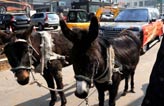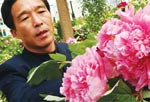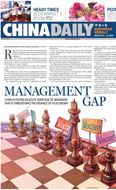Art
Hui opera's future in mist
Updated: 2011-03-11 10:35
By Xie Fang (Chinaculture.org)
The long history of Chinese opera has given risen to numerous regional branches each of which is imprinted with the distinctive local culture of the region. As the name indicates, Hui Opera originated from Huizhou and the surrounding areas of Anqing, Taiping, Qingyang and Shitai in China’s central Anhui Province.
 |
Hui opera is one of the oldest forms of theatre in China, with a history of more than 300 years. It has established a complete artistic format with Chinese opera’s major components – the vocal style, the set tunes and the percussive scores which portray the psychological state of different characters. Particular emphasis is also placed on the highly formalized movements and stage design. The stage art of Hui Opera is rich and varied, with spectacular stage sets. The costumes are simple and of good taste. Hui Opera has experienced highs and lows in its history, but its abundant heritage and distinct national features allowed for its enduring artistic vitality.
 |
Hui Opera was listed in the first batch of national intangible cultural heritage in China in June, 2006. Two years later, the BMW Group, contributed a donation of RMB 1 Million to the Protection Center of Intangible Cultural Heritage of China (PCICH), as part of the “Chinese Intangible Cultural Heritages Protection Fund”. Part of the donation was allocated mainly to the protection and inheritance of Hui Opera.
Last June, “Chinese Regional Opera Series” featured Hui Opera in Hong Kong. The troupe was composed of 44 performers, including the National Class One performer Li Longbin. The troupe has staged many well-preserved works in the traditional repertory, including Flooding the Army, The Drunken Royal Concubine, and The Legend of the White Snake. Their performance gained much attention and concerns over Hui Opera.
 |
Review of history
Hui Opera is one of the most ancient operas in China. Based on the artistic foundation of Qingyang and Kunshan arias, the art form was gradually founded by assimilating the essence of various operas at the end of Ming Dynasty (1368-1644) and the beginning of the Qing Dynasty (1644-1911). In the Kangxi Reign of the Qing Dynasty, Hui Opera started a trend all over the country with its performer’s exquisite skills. In some economic centers of Southern China, rich businessmen even boasted their own private Hui Opera troupes and stages. It enjoyed a full development during Qianlong’s reign (1711-1799) and spread all over China during Daoguang’s reign(1820—1850).
In 1790, the 55th year of Qianlong’s reign, Gao Langting, a well-known local actor, led his Sanqing Hui Opera Troupe to Beijing, the capital in the Qing Dynasty, to celebrate the 80th birthday of Emperor Qianlong. Some other Hui Opera troupes also performed in Beijing successively. During the Jiaqing Reign, the “Four Great Hui Operas Troupes” - namely, Sanqing, Sixi, Hechun and Chuntai - aroused a sensation in the capital.
 |
This was the first time that Hui Opera had been performed in Beijing, and after the birthday celebrations, the four troupes remained in the capital and began to perform for ordinary audiences. The Four Anhui Opera Troupes each has its characteristics: The Sanqing Troupe is good at complex and complete plays, the Sixi Troupe is best at Kunqiang, the Chuntai Troupe features young actors, and the Hechun Troupe is famous for fighting performance.
In order to suit their repertoire and tunes to the taste of cosmopolitan Beijing audiences, the performers of Anhui opera adopted elements from other types of opera, notably Hubei Opera and its typical Pihuang music.
During the Daoguang Reign, Cheng Changgeng, known as the leader of Hui Opera as well as the founder of Peking Opera, embraced and incorporated the advantages of various art forms, and introduced the Erhuang aria from Anqing, Anhui Province. After blending and localizing for about 50 years, the great Peking Opera was born.
E-paper

Rise and shine
The Chinese solar energy industry is heating up following recent setbacks in the nuclear sector
Preview of the coming issue
Bombs aim for regime change
CSI, with a twist
Specials

Donkey-powered Land Rover
Two donkeys pull a broken-down Land Rover in Shenyang, Liaoning province.

China Fashion Week
Models present creations for the Hosa Swimwear Trend Press Conference 2011.

Peony express
Growers of china's unofficial national flower are reaching out to europe for help
